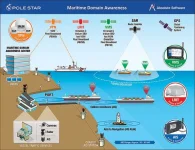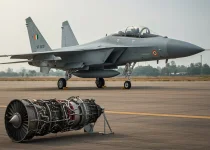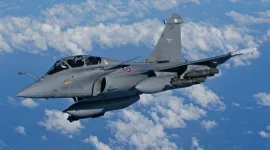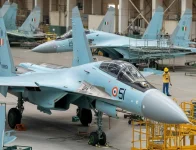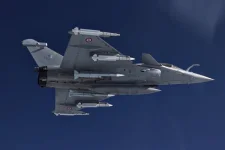- Views: 342
- Replies: 1
The Global Combat Air Programme (GCAP), a collaboration between the United Kingdom, Italy, and Japan, is developing a next-generation stealth fighter known as Tempest, designed with highly ambitious capabilities.
Officials involved in the project, including RAF Group Captain Bill overseeing requirements, indicate the aircraft is being engineered for "really extreme range." This includes the potential capability to fly across the Atlantic Ocean without needing aerial refueling, carrying approximately double the internal payload of an F-35A.
As India considers potential involvement in the GCAP initiative, the fighter's projected performance raises important questions about how it could enhance the Indian Air Force's (IAF) operational endurance and strategic persistence, particularly near sensitive border regions with Pakistan and China.
A key design objective for the Tempest is its exceptional range. The prospect of completing a transatlantic flight – roughly 3,500 nautical miles (6,482 kilometres) – on internal fuel alone signifies a major advancement. This capability would far surpass current fighters like the Eurofighter Typhoon, which requires multiple refueling operations for such distances.
For context, the F-35A has a combat radius of about 670 nautical miles (1,240 km), translating to a total range of approximately 1,340 nautical miles (2,480 km) without refueling. Achieving the 3,500-nautical-mile target would grant the Tempest unparalleled endurance, enabling deep penetration missions without relying on tanker aircraft, which could be vulnerable targets in contested zones like the airspace near India's borders.
Estimating the potential flight endurance of the Tempest over Indian territory requires considering its range, speed, and ability to loiter (remain airborne over an area). While precise specifications are not yet public for the aircraft under development, projections can be made based on its design goals and comparisons with current technology.
Sixth-generation fighters are expected to cruise efficiently at speeds similar to or exceeding current jets like the F-35A (around Mach 0.8). Assuming an efficient cruising speed of approximately 700 mph (1,127 km/h), the Tempest could theoretically cover its maximum projected range of 3,500 nautical miles in about five hours.
However, mission time isn't just about transit; loiter capability is crucial for maintaining presence. Loiter time depends heavily on fuel consumption, which varies significantly between high-speed cruising, combat maneuvering, and slower loitering speeds (typically 300-400 mph or 482-643 km/h) used to conserve fuel while monitoring an area. For modern fighters, loiter time might constitute 20-30% of total flight duration on internal fuel.
Based on a hypothetical 5-hour total flight time, the Tempest might offer 1 to 1.5 hours of loiter time after flying its maximum range. Crucially, if operating closer to its base – for instance, within a 500-nautical-mile radius of an Indian air station – significantly less fuel would be used for travel, potentially extending loiter time to a more substantial 3-4 hours per mission.
Applying these estimates to the IAF's strategic needs offers insight. Key IAF bases such as Ambala near the Pakistan border and Tezpur near the China border are separated by about 1,200 km (approximately 648 nautical miles). A round trip between these locations (2,400 km or 1,296 nautical miles) falls comfortably within the Tempest's projected range.
At an estimated cruise speed of 700 mph, this journey might take around two hours, leaving considerable fuel. This reserve could potentially allow for 2-3 hours of loiter time over either strategic area, assuming roughly half the fuel is used for transit. Such endurance would enable prolonged surveillance missions, sustained air cover, or engagement capacity without the immediate need for refueling, a significant advantage in high-threat environments where tankers face risks from enemy air defence systems.
Beyond range, the Tempest's planned payload capacity is noteworthy. Estimated to be double the F-35A's internal capacity (which is around 5,000 lbs), the Tempest might carry up to 10,000 lbs of ordnance and sensors internally while maintaining stealth. This would allow for a potent mix of long-range air-to-air missiles, precision-guided bombs, and advanced sensor systems.
As described by Group Captain Bill, this combination could enable the Tempest to act as a "quarterback" in complex air battles, managing the operational environment using advanced AI and networking. Over Indian frontiers, this substantial payload could allow a single aircraft to address multiple potential threats, such as Pakistani F-16s or Chinese J-20s, enhancing the IAF's deterrent and combat capabilities.
India has shown interest in the GCAP program since initial discussions in 2019, further explored during former UK Prime Minister Boris Johnson's visit in 2022, particularly concerning software development and potential co-production arrangements. The IAF, currently operating with approximately 31 fighter squadrons against a sanctioned requirement of 42.5, faces the challenge of maintaining effective air power across extensive and contested borders.
The long-range, high-payload characteristics envisioned for the Tempest align well with these operational needs, especially in scenarios where aerial refueling might be restricted or risky, such as areas potentially affected by electronic warfare like GNSS jamming.
However, India's strong emphasis on self-reliance through the "Make in India" (Atmanirbhar Bharat) initiative, prioritizing indigenous programs like the Tejas Mk2 and the Advanced Medium Combat Aircraft (AMCA), presents a complex factor in determining the extent of potential future collaboration with the GCAP partners.
The final decision will likely balance immediate capability needs with long-term indigenous development goals.

